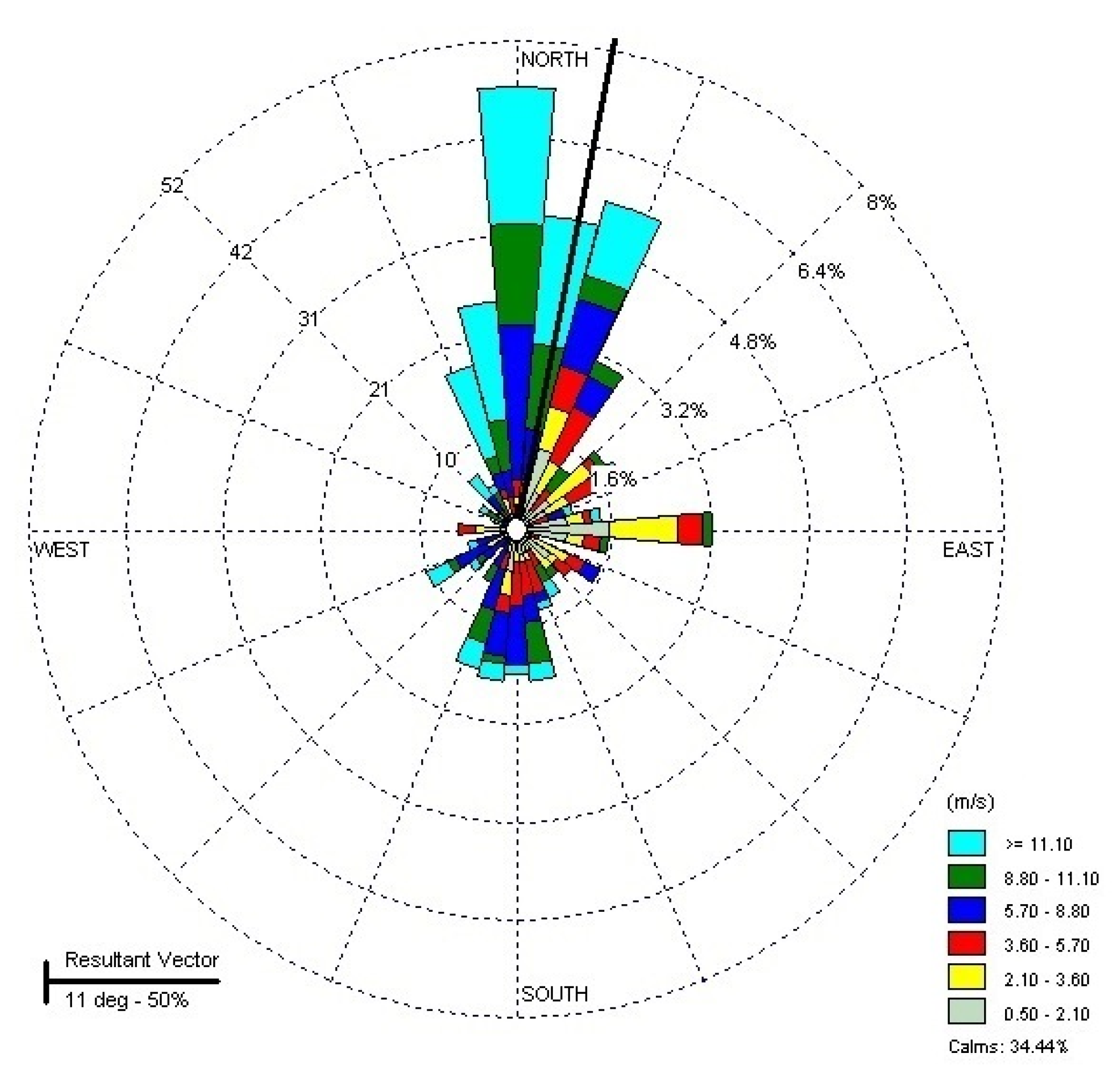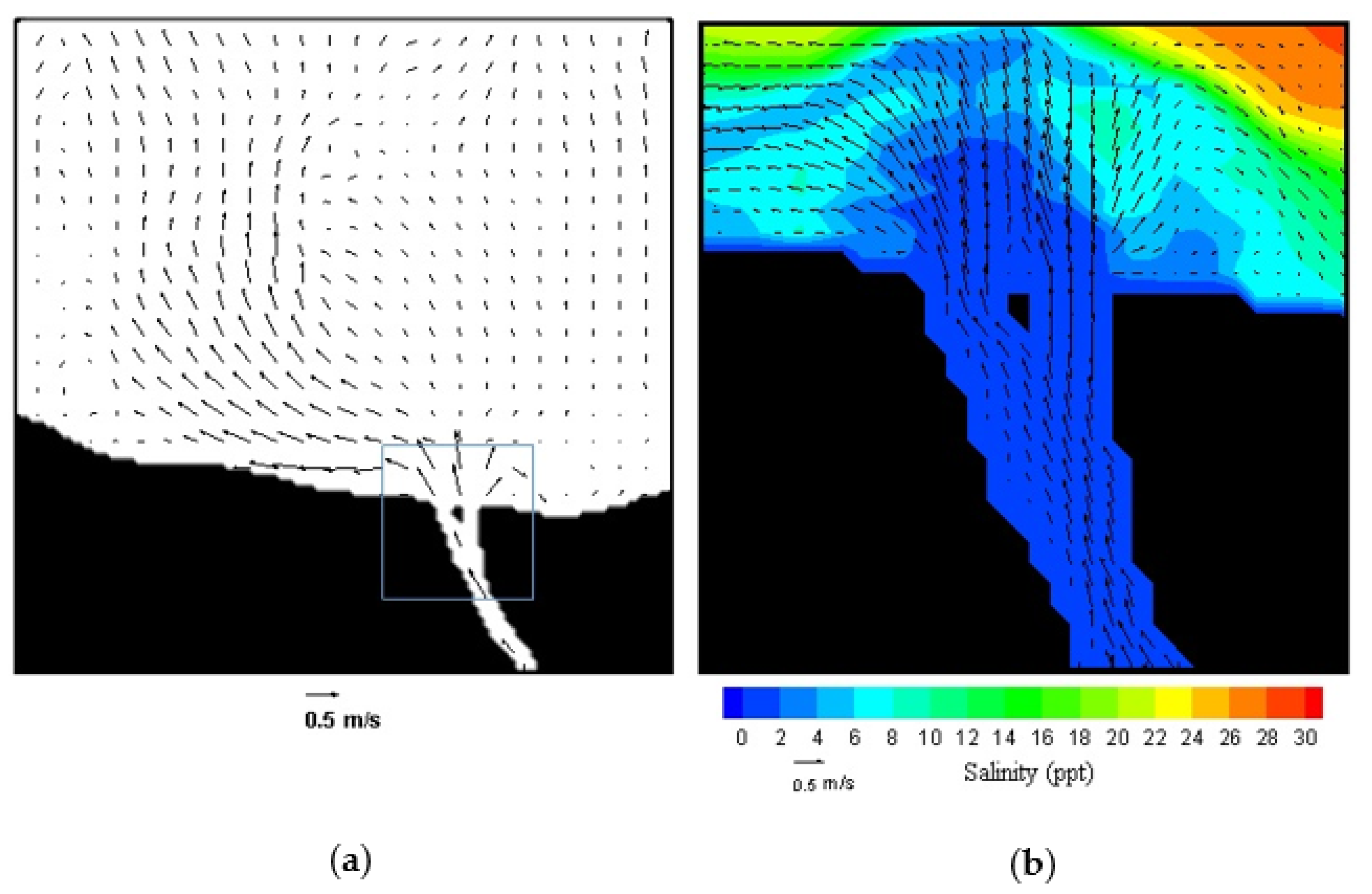Insight of Numerical Simulation for Current Circulation on the Steep Slopes of Bathymetry and Topography in Palu Bay, Indonesia
Abstract
:1. Introduction
2. Methods
3. Results and Discussion
3.1. Large Model
3.1.1. Wind Patterns Palu Bay
3.1.2. Model of the Average Sea Surface Current Generated by Wind
3.1.3. Model of the Average Surface Currents Generated by the Tides
3.1.4. The Average Sea Surface Current Generated by Tides and Winds
3.2. Small Model
3.2.1. Surface Current with Discharge as Generating Force
3.2.2. Current Circulation on Vertical Cross Section
3.2.3. Verification
4. Conclusions
Funding
Institutional Review Board Statement
Informed Consent Statement
Data Availability Statement
Acknowledgments
Conflicts of Interest
References
- Syifa, M.; Kadavi, P.R.; Lee, C.-W. An Artificial Intelligence Application for Post-Earthquake Damage Mapping in Palu, Central Sulawesi, Indonesia. Sensors 2019, 19, 542. [Google Scholar] [CrossRef] [PubMed] [Green Version]
- Ifiginia; Pudyastuti, P.S.; Kuswartomo; Hidayati, N. The Analysis of Backwater Impact on the Increasing of FloodWater Level in Palu River. In AIP Conference Proceedings; AIP Publishing LLC: Melville, NY, USA, 2018; Volume 1977, p. 050007. [Google Scholar]
- Paulik, R.; Gusman, A.; Williams, J.H.; Pratama, G.M.; Lin, S.L.; Prawirabhakti, A.; Sulendra, K.; Zachari, M.Y.; Fortuna, Z.E.D.; Layuk, N.B.P.; et al. Tsunami hazard and built environment damage observations from Palu City after the September 28 2018 Sulawesi earthquake and tsunami. Pure Appl. Geophys. 2019, 176, 3305–3321. [Google Scholar] [CrossRef]
- Metzner, J. Palu (Sulawesi): Problematik der Landnutzung in einem klimatischen Trockental am Äquator (Palu (Sulawesi): Problems of Land Utilization in a Climatic Dry Valley on the Equator). Erdkunde 1981, 35, 42–54. [Google Scholar] [CrossRef]
- Adrikni, W.K.M.; Akhmad, S.A.; Anjar, H.; Amalfi, O.; Asdani, S.A.C.; Defrizal, D.A.Y.R.; Firdaus; Fadli, G.M.; Lucky, D.G.H.; Haunan, A.; et al. Bencana Melanda Geologi Menata, 1st ed.; Badan Geologi Kementerian Energi dan Sumber Daya Mineral: Jakarta, Indonesia, 2018; pp. 2–3. ISBN 978-602-9105-76-6. (In Indonesian)
- Gusman, A.R.; Supendi, P.; Nugraha, A.D.; Power, W.; Latief, H.; Sunendar, H.; Widiyantoro, S.; Wiyono, S.H.; Hakim, A.; Muhari, A.; et al. Source model for the tsunami inside Palu Bay following the 2018 Palu earthquake, Indonesia. Geophys. Res. Lett. 2019, 46, 8721–8730. [Google Scholar] [CrossRef]
- Mason, H.B.; Montgomery, J.; Gallant, A.P.; Hutabarat, D.; Reed, A.N.; Wartman, J.; Irsyam, M.; Simatupang, P.T.; Alatas, I.M.; Prakoso, W.A.; et al. East Palu Valley flowslides induced by the 2018 MW 7.5 Palu-Donggala earthquake. Geomorphology 2021, 373, 107482. [Google Scholar] [CrossRef]
- Syamsidik; Benazir; Muksin, U.; Margaglio, G.; Fitrayansyah, A. Post-tsunami Survey after the September 28, 2018 Tsunami Near Palu Bay of Central Sulawesi, Indonesia: Impacts and Challenges to Coastal Communities. Int. J. Disaster Risk Reduct. 2019, 38, 101229. [Google Scholar] [CrossRef]
- Luthfi, M. Assessment on Damages of Harbor Complexes Due to Impacts of the 2018 Palu-Donggala Tsunami, Indonesia. In International Conference on Asian and Pacific Coasts; Springer: Singapore, 2019; pp. 257–260. [Google Scholar]
- Takagi, H.; Pratama, M.B.; Kurobe, S.; Esteban, M.; Aránguiz, R.; Ke, B. Analysis of Generation and Arrival Time of Landslide Tsunami to Palu City Due to the 2018 Sulawesi Earthquake. Landslides 2019, 16, 983–991. [Google Scholar] [CrossRef]
- Pakoksung, K.; Suppasri, A.; Imamura, F.; Athanasius, C.; Omang, A.; Muhari, A. Simulation of the Submarine Landslide Tsunami on 28 September 2018 in Palu Bay, Sulawesi Island, Indonesia, Using a Two-layer Model. Pure Appl. Geophys. 2019, 176, 3323–3350. [Google Scholar] [CrossRef]
- Heidarzadeh, M.; Muhari, A.; Wijanarto, B. Insights on the Source of the 28 September 2018 Sulawesi Tsunami, Indonesia Based on Spectral Analyses and Numerical Simulations. Pure Appl. Geophys. 2019, 176, 25–43. [Google Scholar] [CrossRef] [Green Version]
- Muhari, A.; Imamura, F.; Arikawa, T.; Hakim, A.R.; Afriyanto, F. Solving the Puzzle of the September 2018 Palu, Indonesia, Tsunami Mystery: Clues from the Tsunami Waveform and the Initial Field Survey Data. J. Disaster Res. 2018, 13. [Google Scholar] [CrossRef]
- Liu, P.L.F.; Higuera, P.; Husrin, S.; Prasetya, G.S.; Prihantono, J.; Diastomo, H.; Pryambodo, D.G.; Susmoro, H. Coastal Landslides in Palu Bay during 2018 Sulawesi Earthquake and Tsunami. Landslides 2020, 17, 2085–2098. [Google Scholar] [CrossRef]
- Nakata, K.; Katsumata, A.; Muhari, A. Submarine Landslide Source Models Consistent with Multiple Tsunami Records of the 2018 Palu Tsunami, Sulawesi, Indonesia. Earth Planets Space 2020, 72, 1–16. [Google Scholar] [CrossRef] [Green Version]
- Weatherall, P.; Marks, K.M.; Jakobsson, M.; Schmitt, T.; Tani, S.; Arndt, J.E.; Rovere, M.; Chayes, D.; Ferrini, V.; Wigley, R. A New Digital Bathymetric Model of the World’s Oceans. Earth Space Sci. 2015, 2, 331–345. [Google Scholar] [CrossRef]
- HydroQual, Inc. A Primer for ECOMSED, Users Manual (Version 1.3); HydroQual, Inc.: Mahwah, NJ, USA, 2002; p. 07430. [Google Scholar]
- Lai, Y.G.; Wu, K. A Three-Dimensional Flow and Sediment Transport Model for Free-Surface Open Channel Flows on Unstructured Flexible Meshes. Fluids 2019, 4, 18. [Google Scholar] [CrossRef] [Green Version]
- Mellor, G.L. Users Guide for a Three Dimensional, Primitive Equation, Numerical Ocean Model; Program in Atmospheric and Oceanic Sciences, Princeton University: Princeton, NJ, USA, 1998. [Google Scholar]
- Seo, H.; Miller, A.J.; Norris, J.R. Eddy–wind Interaction in the California Current System: Dynamics and impacts. J. Phys. Oceanogr. 2016, 46, 439–459. [Google Scholar] [CrossRef]
- Khoirunnisa, H.; Karima, S. The Condition of Significant Wave Height and Wind Velocity in Makassar Strait During 2017. J. Appl. Geospat. Inf. 2019, 3, 179–189. [Google Scholar] [CrossRef]
- BMKG. Buletin Cuaca dan Iklim Maritim; BMKG: Jakarta, Indonesia, 2018; Volume 2, p. 20. (In Indonesian)
- Longuet-Higgins, M.S.; Stewart, R.W. Changes in the Form of Short Gravity Waves on Long Waves and Tidal Currents. J. Fluid Mech. 1960, 8, 565–583. [Google Scholar] [CrossRef]
- Echevarria, E.R.; Hemer, M.A.; Holbrook, N.J. Global Implications of Surface Current Modulation of the Wind-wave Field. Ocean Model. 2021, 161, 101792. [Google Scholar] [CrossRef]
- Davarpanah Jazi, S.; Wells, M.G.; Peakall, J.; Dorrell, R.M.; Thomas, R.E.; Keevil, G.M.; Darby, S.E.; Sommeria, J.; Viboud, S.; Valran, T. Influence of Coriolis Force Upon Bottom Boundary Layers in a Large-scale Gravity Current Experiment: Implications for Evolution of Sinuous Deep-water Channel Systems. J. Geophys. Res. Ocean. 2020, 125, e2019JC015284. [Google Scholar] [CrossRef]
- Bressan, A.; Constantin, A. The Deflection Angle of Surface Ocean Currents from the Wind Direction. J. Geophys. Res. Ocean. 2019, 124, 7412–7420. [Google Scholar] [CrossRef] [Green Version]
- Boyd, J.P. Dynamics of the Equatorial Ocean; Springer: Berlin/Heidelberg, Germany, 2018. [Google Scholar]
- Pudjaprasetya, S.R.; Risriani, V.M.; Iryanto. Numerical Simulation of Propagation and Run-Up of Long Waves in U-Shaped Bays. Fluids 2021, 6, 146. [Google Scholar] [CrossRef]
- Lutfi, M. Three Dimensional Numerical Modeling of Current and Temperature Distribution in the Estuary of Palu River. J. Phys. Conf. Ser. 2019, 1354, 012020. [Google Scholar] [CrossRef]
- Bayhaqi, A.; Wisha, U.J.; Surinati, D. Modeling Tidal Current of Banten Bay during Transitional Monsoons 2015–2016. J. Segara 2018, 14, 95–105. [Google Scholar]
- Pamungkas, A.; Farhaby, M.A. Hydro-Oceanography Modelling Characteristic (Tides, Waves, and Currents) in Kelabat Bay, Bangka Belitung. In Proceedings of the International Conference on Maritime and Archipelago (ICoMA 2018), Bangka Belitung, Indonesia, 13–15 September 2019; pp. 178–182. [Google Scholar]
- Lin, H.; Chen, Z.; Hu, J.; Cucco, A.; Zhu, J.; Sun, Z.; Huang, L. Numerical simulation of the Hydrodynamics and Water Exchange in Sansha Bay. Ocean Eng. 2017, 139, 85–94. [Google Scholar] [CrossRef]
- Anugrah, N.N.; Samad, W.; Berlianty, D. The Changes in Oceanographic Condition of Makassar Strait Related with El Nino Southern Oscillation (ENSO) Events of 2009–2019. In IOP Conference Series: Earth and Environmental Science; IOP Publishing: Bristol, UK, 2020; Volume 618, p. 012017. [Google Scholar]
- Sprintall, J.; Wijffels, S.E.; Molcard, R.; Jaya, I. Direct Estimates of the Indonesian Throughflow Entering the Indian Ocean: 20042006. J. Geophys. Res. Ocean. 2009, 114, 2004–2006. [Google Scholar]
- Gordon, A.L.; Susanto, R.D.; Ffield, A.; Huber, B.A.; Pranowo, W.; Wirasantosa, S. Makassar Strait Throughflow, 2004 to 2006. Geophys. Res. Lett. 2008, 35, 3–7. [Google Scholar] [CrossRef] [Green Version]
- Qu, T.; Song, Y.T.; Yamagata, T. An introduction to the South China Sea Throughflow: Its Dynamics, Variability, and Application for Climate. Dyn. Atmos. Oceans 2009, 47, 3–14. [Google Scholar] [CrossRef]
- Mayer, B.; Damm, P.E. The Makassar Strait Throughflow and Its jet. J. Geophys. Res. Oceans 2012, 117, C7. [Google Scholar] [CrossRef]
- Lutfi, M. Hydrodynamics Circulation Model in the Estuary of Palu River Based on Numerical Calculations. J. Eng. Sci. Technol. 2020, 15, 2309–2323. [Google Scholar]
- Radjawane, I.M.; Riandini, F. Numerical Simulation of Cohesive Sediment Transport in Jakarta Bay. Int. J. Remote Sens. Earth Sci. 2009, 6, 65–76. [Google Scholar] [CrossRef]
- Mishima, T.; Yamashita, T.; Komaguti, T.; Riandini, F. Appliction of Simulation Model for Cohesive Sediment Transport and Bottom Topography Changes to Tidal Flat. Proc. Hydraul. Eng. 2008, 52, 1333–1338. [Google Scholar] [CrossRef]
- Choi, B.H.; Eum, H.M.; Woo, S.B. Modeling of Coupled Tide-wave-surge Process in the Yellow Sea. Ocean Eng. 2003, 30, 739–759. [Google Scholar] [CrossRef]
- Cossa, O.; Pous, S.; Penven, P.; Capet, X.; Reason, C.J.C. Modelling Cyclonic Eddies in the Delagoa Bight Region. Cont. Shelf Res. 2016, 119, 14–29. [Google Scholar] [CrossRef] [Green Version]
- Johnson, J.A.; Hill, R.B. A Three-dimensional Model of the Southern Ocean with Bottom Topography. Deep-Sea Res. Oceanogr. Abstr. 1975, 22, 745–751. [Google Scholar] [CrossRef]









Publisher’s Note: MDPI stays neutral with regard to jurisdictional claims in published maps and institutional affiliations. |
© 2021 by the author. Licensee MDPI, Basel, Switzerland. This article is an open access article distributed under the terms and conditions of the Creative Commons Attribution (CC BY) license (https://creativecommons.org/licenses/by/4.0/).
Share and Cite
Lutfi, M. Insight of Numerical Simulation for Current Circulation on the Steep Slopes of Bathymetry and Topography in Palu Bay, Indonesia. Fluids 2021, 6, 234. https://doi.org/10.3390/fluids6070234
Lutfi M. Insight of Numerical Simulation for Current Circulation on the Steep Slopes of Bathymetry and Topography in Palu Bay, Indonesia. Fluids. 2021; 6(7):234. https://doi.org/10.3390/fluids6070234
Chicago/Turabian StyleLutfi, Mohammad. 2021. "Insight of Numerical Simulation for Current Circulation on the Steep Slopes of Bathymetry and Topography in Palu Bay, Indonesia" Fluids 6, no. 7: 234. https://doi.org/10.3390/fluids6070234
APA StyleLutfi, M. (2021). Insight of Numerical Simulation for Current Circulation on the Steep Slopes of Bathymetry and Topography in Palu Bay, Indonesia. Fluids, 6(7), 234. https://doi.org/10.3390/fluids6070234




